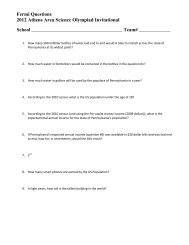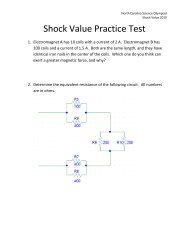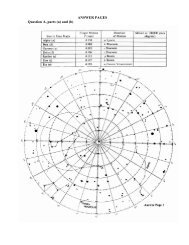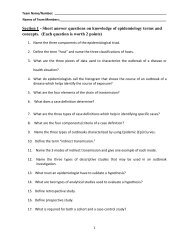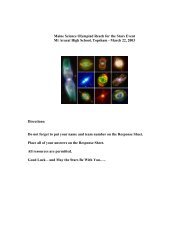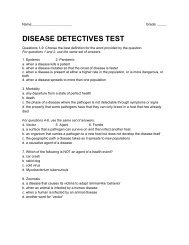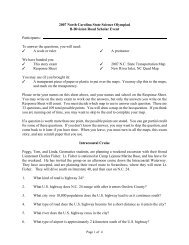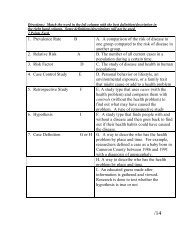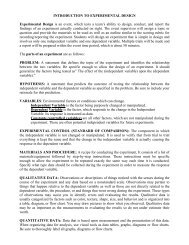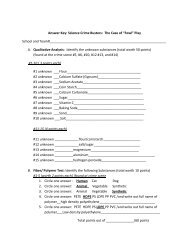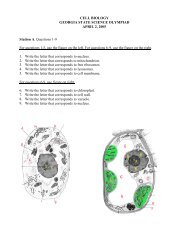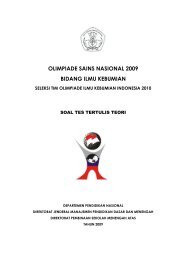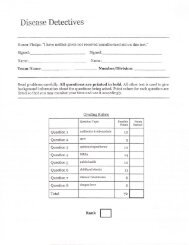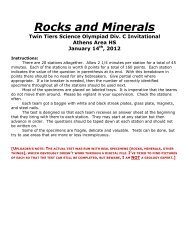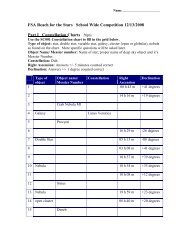You also want an ePaper? Increase the reach of your titles
YUMPU automatically turns print PDFs into web optimized ePapers that Google loves.
Team Name+Number ________________________<br />
Teammate 1 name _______________________ Teammate 2 name ________________________<br />
<strong>Dynamic</strong> <strong>Planet</strong>: <strong>Glaciers</strong><br />
(by Shad160)<br />
The following test is 80 questions long, split up into four different sections. The first 20<br />
questions are worth 40 total points and the following 60 questions are worth 60 total points,<br />
adding up to a grand total of 100 points. All questions are related to glaciers in one way or<br />
another, and each question can be easily found on the internet; there is no trickery here, just<br />
a test of how well you have done your research and how well you have prepared yourself for<br />
this event.<br />
The tiebreakers are as follows:<br />
1 st tiebreaker- Number of questions gotten right from Section C<br />
2 nd tiebreaker- Number of questions gotten right from Section A<br />
3 rd tiebreaker- Number of questions gotten right from Section B<br />
4 th tiebreaker- Number of questions gotten right from Section D<br />
There is an attached answer sheet that you may rip off. You have 50 minutes to complete this<br />
test and may use up to 4 double sided pages (8 ½” by 11”) worth of notes. Good Luck!
Section A<br />
Match the glacial feature with the type that forms them, and write out whether<br />
they are erosional or depositional features. (2 points per question)<br />
A. Continental <strong>Glaciers</strong> B. Valley <strong>Glaciers</strong> C. Both Continental and Valley<br />
1. Arêtes<br />
2. Horns<br />
3. Hanging Valleys<br />
4. Truncated Spurs<br />
5. Kettles<br />
6. Kames<br />
7. Drumlins<br />
8. Eskers<br />
9. Cirques<br />
10. Glacial troughs<br />
11. Roche Moutonnées<br />
12. Tarns<br />
13. Fjords<br />
14. Paternoster Lakes<br />
15. Moraines<br />
16. Tunnel Valleys<br />
17. Outwash fans<br />
18. Striations<br />
19. Erratics<br />
20. Crags
Section B<br />
Choose the (most) correct answer for the following multiple choice questions.<br />
(1 point per question)<br />
21. How many distinct glaciations affected North America during the Pleistocene?<br />
a) One<br />
b) Two<br />
c) Three<br />
d) Four<br />
22. Firn is formed as the result of<br />
a) Changes in the flow rate of glacial meltwater<br />
b) The partial melting and refreezing of snow crystals into small grains of ice<br />
c) The polishing of bedrock by the scraping action of glacial ice<br />
d) The deposition of unsorted glacial drift<br />
23. Till is best defined as<br />
a) an unsorted deposit of rock material<br />
b) sediment sorted by melted ice<br />
c) sorted and layered deposits of sand<br />
d) unsorted deposits of drift<br />
24. The last ice age ended approximately ____ years ago.<br />
a) 100,000<br />
b) 70,000<br />
c) 10,000<br />
d) 6,000<br />
25. Large masses of ice on land that show evidence of movement are called ______.<br />
a) ice packs<br />
b) glaciers<br />
c) icebergs<br />
d) all of these<br />
26. The snow line is _________.<br />
a) the lowest altitude at which snow will fall in the warm months<br />
b)the lowest altitude at which snow will fall in the cool months<br />
c) the altitude above which snow does not completely melt in the warm months<br />
d) the altitude above which snow does not completely melt in the cool months
27. Which of the following forms of ice has the greatest density?<br />
a)firn<br />
b)glacial ice<br />
c)granular ice<br />
d)snow<br />
28. Which of the following erosional features is characteristic of rivers and not glaciers?<br />
a) arete<br />
b) cirque<br />
c) V-shaped valley<br />
d) roche moutonée<br />
29. Glacial drift that has been modified, sorted, and distributed by meltwater streams is called<br />
______.<br />
a) outwash<br />
b) till<br />
c) moraine<br />
d) rock flour<br />
30. Carbon dioxide in the atmosphere ___________.<br />
a) is low during glacial periods<br />
b) is high during glacial periods<br />
c) is constant between glacial and interglacial periods<br />
d) varies in a manner unrelated to glacial and interglacial periods<br />
31. Calving refers to the process of<br />
a) Three or more cirque glaciers meeting to form a peak<br />
b) Long, parallel grooves being etched into bedrock by a moving glacier<br />
c) Large pieces of ice breaking off to form icebergs<br />
d) A knob of bedrock being carved into a hill<br />
32. What rock type is conclusive evidence of past glaciation?<br />
a) Conglomerate.<br />
b) Pegmatite.<br />
c) Phyllite.<br />
d) Tillite.<br />
33. Which sea froze over during the little ice age?<br />
a) The Red Sea<br />
b) The Baltic Sea<br />
c) The Dead Sea<br />
d) The Mediterranean Sea
34. Varve deposits are formed when ______ is deposited in the summer and _______ is deposited in<br />
the winter.<br />
a)gravel, sand<br />
b)fine clay, sand<br />
c)coarse silt, gravel<br />
d)coarse silt, fine clay<br />
35. Glaciation formed by ___________ of snow<br />
a)burial and metamorphism<br />
b)melting and refreezing<br />
c)erosion and deposition<br />
d)precipitation and melting<br />
36. What was the name of the ice sheet that covered most of North America during the most recent<br />
ice age?<br />
a) Cordilleran Ice Sheet<br />
b) Laurentide Ice Sheet<br />
c) Midlandian Ice Sheet<br />
d) Cypress Ice Sheet<br />
37. The end of a glacier is located:<br />
a)Where it meets an obstacle<br />
b)Where the average annual temperature equals 32 degrees F.<br />
c)Where snowfall plus inflow equals melting plus evaporation<br />
d)Where one year's snow just melts before the next year's snow begins<br />
38. When a glacier retreats, a rock trapped within the ice<br />
a) continues to move toward the foot of the glacier<br />
b) retreats more slowly than the glacier front<br />
c) retreats as fast as the glacier front<br />
d) retreats faster than the glacial front<br />
39. The farthest advance of an alpine valley glacier is marked by a deposit of:<br />
a)Medial moraine<br />
b)Lateral moraine<br />
c)Recessional moraine<br />
d)Terminal moraine<br />
40. The process of glacial ice pulling away large blocks of rock is:<br />
a)Grooving<br />
b)Plucking<br />
c)Abrasion<br />
d)Surging
Section C<br />
Match the following vocabulary words with their definitions (1 point per question)<br />
A. Stratugi B. Suncups C.Nunatak D.Cryoconites E.Katabatic F.Diagenic Mounds<br />
G. Hoarfrost H. Firn I. Furrow J. Ablation K. Bergschrund L. Cwm M. Ogives<br />
N. Rock Flour O. Proglacial P. Avalanche Q. Varve R.Fjord S. Gendarmes T. Glacier<br />
41. A melted bowl-shaped depression in ice due to insolation ____<br />
42. Mountains sticking up out of ice sheets ____<br />
43. Snow dune ____<br />
44. Conical shapes up to two meters high covered with rock material ____<br />
45. Long grooves in subglacial till or pavement gouged by englacial debris. ____<br />
46. A light, feathery coating of ice. ____<br />
47. Pulverized rock of the smaller size sediment classes (silts and clays) produced by glacial milling can<br />
give outwash streams a milky appearance. ____<br />
48. German word for “Last year’s snow” ____<br />
49. A wind that flows from a glacier, caused by air cooled by the ice becoming heavier than surrounding<br />
air, then draining down-valley. ____<br />
50. The area in front of, or just at the outer edge of a glacier. ____<br />
51. In glaciers, refers to melting, erosion and evaporation which reduces the area of the ice.<br />
52. The ice wall commonly found at the head of a glacier which has separated slightly from the rock wall<br />
of its cirque. ____<br />
53. A steep-walled semicircular basin in a mountain caused by glacial erosion. After glaciation, the<br />
depression may contain a lake. ____<br />
54. Clay sized material deposited in glacial lakes during both summer and winter. ____<br />
55. Ice towers such as seracs and penitantes. ____<br />
56. A large mass of snow, ice or rock moving down a steep part of the glacier under the influence of<br />
gravity.<br />
57. Steep-sided inlets of the sea which occur in flooded glacial troughs. ____<br />
58. A large long lasting accumulation of snow and ice that develops on land. ____<br />
59. Small holes 2-10 cm deep melted in glacial surfaces by small rocks. ____
60. Alternating wave crests and valleys that appear as dark and light bands of ice on glacier surfaces. ___<br />
Section D<br />
Label the following diagrams correctly (1 point per question).
Team Name+Number ________________________ Teammate Names ____________________<br />
Section A<br />
1. ________, ______________<br />
2. ________, ______________<br />
3. ________, ______________<br />
4. ________, ______________<br />
5. ________, ______________<br />
6. ________, ______________<br />
7. ________, ______________<br />
8. ________, ______________<br />
9. ________, ______________<br />
10. ________, ______________<br />
11. ________, ______________<br />
12. ________, ______________<br />
13. ________, ______________<br />
14. ________, ______________<br />
15. ________, ______________<br />
16. ________, ______________<br />
17. ________, ______________<br />
18. ________, ______________<br />
19. ________, ______________<br />
20. ________, ______________<br />
Section B<br />
21. ________<br />
22. ________<br />
23. ________<br />
24. ________<br />
25. ________<br />
26. ________<br />
27. ________<br />
28. ________<br />
29. ________<br />
30. ________<br />
31. ________<br />
32. ________<br />
33. ________<br />
34. ________<br />
35. ________<br />
36. ________<br />
37. ________<br />
38. ________<br />
39. ________<br />
40. ________<br />
Section C<br />
41. ________<br />
42. ________<br />
43. ________<br />
44. ________<br />
45. ________<br />
46. ________<br />
47. ________<br />
48. ________<br />
49. ________<br />
50. ________<br />
51. ________<br />
52. ________<br />
53. ________<br />
54. ________<br />
55. ________<br />
56. ________<br />
57. ________<br />
58. ________<br />
59. ________<br />
60. ________<br />
Section D<br />
61. ______________________<br />
62. ______________________<br />
63. ______________________<br />
64. ______________________<br />
65. ______________________<br />
66. ______________________<br />
67. ______________________<br />
68. ______________________<br />
69. ______________________<br />
70. ______________________<br />
71. ______________________<br />
72. ______________________<br />
73. ______________________<br />
74. ______________________<br />
75. ______________________<br />
76. ______________________<br />
77. ______________________<br />
78. ______________________<br />
79. ______________________<br />
80. ______________________



